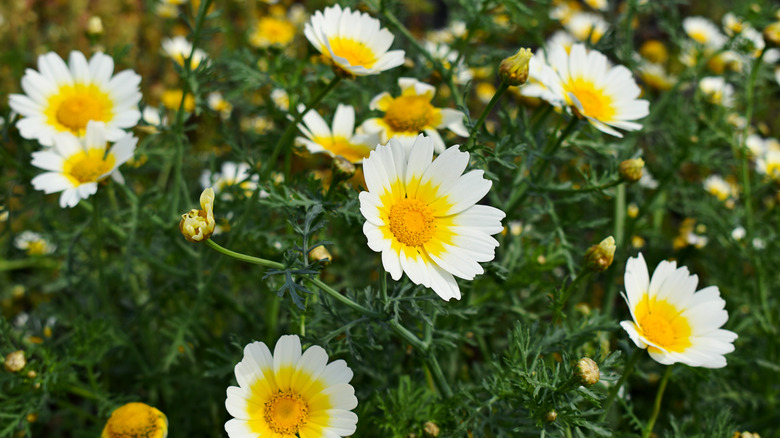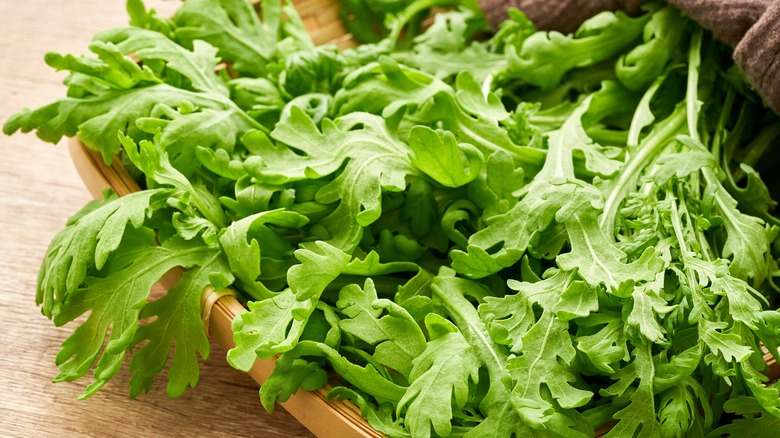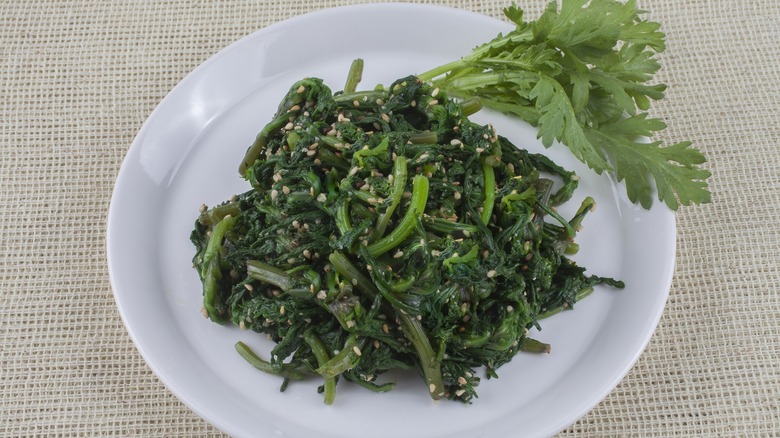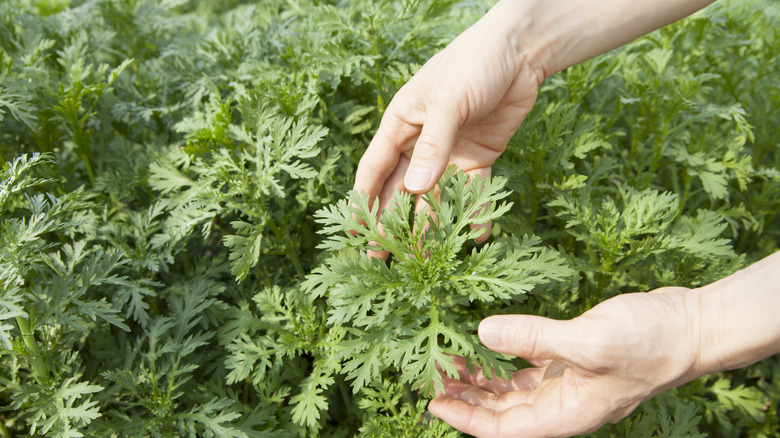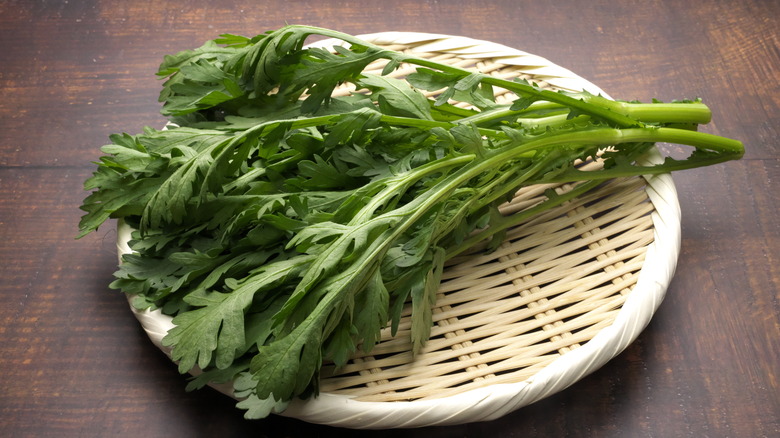What Are Chrysanthemum Greens And What Do They Taste Like?
If you have been to a florist, chances are you have seen chrysanthemums. Part of the aster family (the same family as daisies), these flowers come in many sizes, colors, and shapes, from tiny bonsai plants to large, globular specimens. On occasion, you might see flowers as a garnish on your dinner plate. However, if you encountered any chrysanthemum dishes on a menu in an Asian restaurant, the greens that were presented are not the same as the ornamental plants. Commonly called crown daisies or garland chrysanthemum, the plant known as "chrysanthemum" on the menu is scientifically known as Glebionis coronaria. Although it was originally grouped together with their ornamental cousins, they have since been given their own genus to distinguish them. It is considered a leafy herb.
Crown Daisies originate from southern Europe around the Mediterranean, but they are now mostly cultivated in Asia where it is commonly eaten as a vegetable. When mature, they grow up to over two feet tall. Their flowers are small with white petals that grow yellow towards the center (like a crown), and the leaves are long and slender with serrated edges.
What do chrysanthemum greens taste like?
Compared to other leafy vegetables, such as lettuce or bok choy, chrysanthemum greens have a stronger flavor profile. This green has been described as herbaceous, floral, grassy, peppery, and bitter. To imagine how it tastes, think of mustard greens. The bitterness is magnified when it is cooked too long, so be sure to cook it lightly.
The taste of chrysanthemum greens also changes depending on its age. Younger specimens harvested before flowering have a more mild taste while leaves harvested after flowering are considerably more bitter. In terms of texture, the leaves are tender, slightly crunchy, and succulent, and the stalks are slightly fibrous and crunchy.
While the flowers themselves are edible, the center is bitter. The petals can be used fresh in salads, soups, or as a garnish. Sometimes unopened buds can be found among the greens in the market, and you can cook them as you would the greens themselves.
How to cook with chrysanthemum greens
You can eat Chrysanthemum greens both raw and cooked. If you happen to have very fresh young greens, you can make a salad with them. Wash the leaves thoroughly and dry them with paper towels before cutting or tearing them into bite-sized pieces. In a pan, fry minced garlic, grated ginger, and sliced chilis on low heat until fragrant. In a bowl, mix sesame oil with soy sauce, rice wine vinegar or Chinese black vinegar, and sugar. Add this mixture to the pan and combine thoroughly. Pour everything over the greens (and other optional vegetables) and serve.
For older, tougher leaves that are not suitable for salads, there are many recipes that make good use of the vegetable, from tempura to hot pots (nabe or nabemono in Japanese). A simple recipe worth trying is Japanese ohitashi, a simple dish of chilled cooked greens marinated in dashi and soy sauce. Blanch chrysanthemum greens in boiling water, shock them in an ice bath to stop the cooking process, and squeeze out as much water as possible with paper towels or cheese cloth. Combine dashi (you can use instant dashi powder or make your own), soy sauce, and mirin (Japanese cooking sake), and bring it to a brief boil. Place the blanched chrysanthemum greens in the sauce mixture and let them marinate for at least three hours in the refrigerator until chilled. To serve, arrange the greens on a plate, drizzle with the marinade, garnish with sesame seeds, and enjoy.
Where to buy chrysanthemum greens
Chrysanthemum greens are not easily found in the average grocery store, but you can usually find them in Asian markets. It is in season during the fall and winter, so look for them between November and March.
Depending on the kind of market near you, chrysanthemum greens are labeled with different names. In Japanese markets, they are known as Shungiku (春菊) in eastern Japan and Kikuna (菊菜) in western Japan. In Chinese markets, it is marketed as tong-ho (茼蒿) although it can also be called "chop suey greens" in some places. In Korean markets, it is called ssukgat (쑥갓). And although it is not often used in Western cuisines, it is used on the island of Crete in Greece where the word for this plant is mantilida.
When buying chrysanthemum greens, pay attention to the leaves. Good quality chrysanthemum greens have bright green and shiny leaves. Avoid the ones with yellowing or darkening leaves. In addition, you should choose the ones that have the thinnest stalks, which are younger, have a milder flavor, and are easier to eat. Use the greens as soon as possible after purchase, as they do not store well.
Nutritional information about chrysanthemum greens
Like many other vegetables, chrysanthemum greens are a healthy food that contain a wide variety of nutrients. They contain no cholesterol, saturated fats, or sugar. A 100-gram (3.5 oz) serving of the greens contains 24 total calories and includes 13% of the recommended daily intake (RDI) of iron, 9% of calcium, 12% of potassium, and 5% of sodium. Each portion of chrysanthemum greens also has a small amount of fat (1% of recommended daily intake) and carbohydrates (also at 1%), but within those carbs is a significant amount (11% of RDI) of dietary fiber. In addition, chrysanthemum greens are also a source of folate and vitamins A, C, B1, B2, B3, B5, B6, and B9.
Currently, there are no scientific studies about the potential benefits of consuming chrysanthemum greens beyond the nutrients listed above, making it a standard, healthy vegetable. Commercial supplies are grown conventionally — although seeds are available to purchase if you want to grow them organically. They are not a genetically modified organism (GMO).

